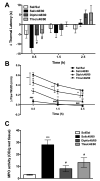Mast cell degranulation mediates compound 48/80-induced hyperalgesia in mice
- PMID: 22828511
- PMCID: PMC3428491
- DOI: 10.1016/j.bbrc.2012.07.074
Mast cell degranulation mediates compound 48/80-induced hyperalgesia in mice
Abstract
Mast cells mediate allergies, hypersensitivities, host defense, and venom neutralization. An area of recent interest is the contribution of mast cells to inflammatory pain. Here we found that specific, local activation of mast cells produced plantar hyperalgesia in mice. Basic secretagogue compound 48/80 induced plantar mast cell degranulation accompanied by thermal hyperalgesia, tissue edema, and neutrophil influx in the hindpaws of ND4 Swiss mice. Blocking mast cell degranulation, neutrophil extravasation, and histamine signaling abrogated these responses. Compound 48/80 also produced edema, pain, and neutrophil influx in WT C57BL/6 but not in genetically mast cell-deficient C57BL/6-Kit(W-sh)(/)(W-sh) mice. These responses were restored following plantar reconstitution with bone marrow-derived cultured mast cells.
Copyright © 2012 Elsevier Inc. All rights reserved.
Figures




Similar articles
-
Intraperitoneal influx of neutrophils in response to IL-33 is mast cell-dependent.Blood. 2013 Jan 17;121(3):530-6. doi: 10.1182/blood-2012-05-434209. Epub 2012 Oct 23. Blood. 2013. PMID: 23093619
-
Mast cells mediate neutrophil recruitment during atherosclerotic plaque progression.Atherosclerosis. 2015 Aug;241(2):289-96. doi: 10.1016/j.atherosclerosis.2015.05.028. Epub 2015 Jun 3. Atherosclerosis. 2015. PMID: 26062988
-
An essential role for mast cells as modulators of neutrophils influx in collagen-induced arthritis in the mouse.Lab Invest. 2011 Jan;91(1):33-42. doi: 10.1038/labinvest.2010.140. Epub 2010 Aug 16. Lab Invest. 2011. PMID: 20714326 Free PMC article.
-
[Development of the research in the field of histamine release].Yakugaku Zasshi. 1994 Mar;114(3):147-59. doi: 10.1248/yakushi1947.114.3_147. Yakugaku Zasshi. 1994. PMID: 7514663 Review. Japanese.
-
Mast Cell-Mediated Mechanisms of Nociception.Int J Mol Sci. 2015 Dec 4;16(12):29069-92. doi: 10.3390/ijms161226151. Int J Mol Sci. 2015. PMID: 26690128 Free PMC article. Review.
Cited by
-
Mechanisms mediating nitroglycerin-induced delayed-onset hyperalgesia in the rat.Neuroscience. 2016 Mar 11;317:121-9. doi: 10.1016/j.neuroscience.2016.01.005. Epub 2016 Jan 11. Neuroscience. 2016. PMID: 26779834 Free PMC article.
-
Immune Actions on the Peripheral Nervous System in Pain.Int J Mol Sci. 2021 Feb 1;22(3):1448. doi: 10.3390/ijms22031448. Int J Mol Sci. 2021. PMID: 33535595 Free PMC article. Review.
-
Amblyomma americanum serpin 27 (AAS27) is a tick salivary anti-inflammatory protein secreted into the host during feeding.PLoS Negl Trop Dis. 2019 Aug 26;13(8):e0007660. doi: 10.1371/journal.pntd.0007660. eCollection 2019 Aug. PLoS Negl Trop Dis. 2019. PMID: 31449524 Free PMC article.
-
Measuring changes in tactile sensitivity in the hind paw of mice using an electronic von Frey apparatus.J Vis Exp. 2013 Dec 19;(82):e51212. doi: 10.3791/51212. J Vis Exp. 2013. PMID: 24378519 Free PMC article.
-
Repeated hapten exposure induces persistent tactile sensitivity in mice modeling localized provoked vulvodynia.PLoS One. 2017 Feb 3;12(2):e0169672. doi: 10.1371/journal.pone.0169672. eCollection 2017. PLoS One. 2017. PMID: 28158195 Free PMC article.
References
-
- Oliveira SM, Drewes CC, Silva CR, et al. Involvement of mast cells in a mouse model of postoperative pain. Eur. J. Pharmacol. 2011;672:88–95. - PubMed
Publication types
MeSH terms
Substances
Grants and funding
LinkOut - more resources
Full Text Sources
Other Literature Sources

